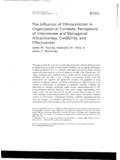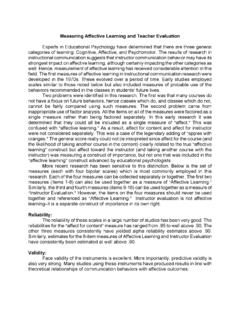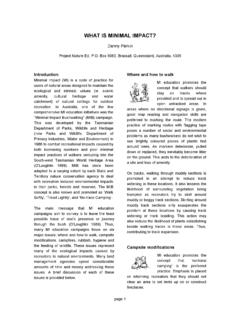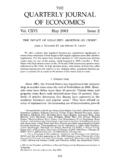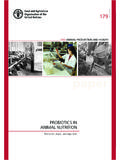Transcription of THE IMPACT OF PERCEPTIONS OF LEADERSHIP …
1 113. THE IMPACT OF PERCEPTIONS OF LEADERSHIP . STYLE, USE OF POWER, AND. CONFLICT management STYLE ON. organizational OUTCOMES. VIRGINIA P. RICHMOND. JOHN P. WAGNER. JAMES C. MCCROSKEY. The degree of association between supervisor and subordinate PERCEPTIONS of the supervisor's LEADERSHIP style, use of power by the supervisor, and the supervisor's conflict- management style was studied in 87. organizational units representing five service-oriented organizations. The ability of the supervisors' and subordinates' PERCEPTIONS , individually and jointly, and the discrepancy between these PERCEPTIONS to predict subordinate satisfaction with supervision and work, subordinate solidarity with supervisor, and degree of subordinate anxiety about communicating with the supervisor were also examined.
2 Virginia P. Richmond ( University of Nebraska, Lincoln, (977) is Associate Professor of Speech Communication at West VirginiaUniversity. James C. McCroskey ( , Penn State University, (966) is Chairperson at West Virginia University in the Speech Communication Department. John P. Wagner received his in Speech Communication from West Virginia University in August 1980. Two of the major concerns of most organizations Student, 1968; for conflict, see Deutsch, 1973;. in contemporary society are productivity and Katz & Kahn, 1966; Serelson & Steiner, 1964).)
3 Employee satisfaction. In profit-making organiza- tions, productivity is directly related to the achieve- Theoretical Orientation ment of the primary goal of the organization- increasing the profit margin. In non-profit organiza- A mediational model of the relationship between tions increased productivity can lead to increased the behaviors of supervisors and the productivity service. Employee satisfaction, although frequently and satisfaction of subordinates was employed in not directly related to productivity, is tied to turnover the current investigation.
4 The components of that rates and absenteeism which are major financial model include the supervisor's intent, the supervi- drains on profit and non-profit organizations alike. sor's behavior, the subordinates' PERCEPTIONS of the Literally thousands of studies have been reported supervisor's behavior, and the resulting satisfaction which have sought to link a wide variety of variables and productivity of the subordinate. with productivity and / or satisfaction. A substantial This perspective views subordinates' percep- number of these studies have examined the role of tions as the primary precursors of their productivity communication in increasing productivity and satis- and satisfaction.
5 One, but only one, of the elements faction. A general conclusion that may be drawn impacting those PERCEPTIONS is the behavior of the from this research is that communication between superior. Many other factors, most of which are not supervisor and subordinates does have an impor- under the direct control of the supervisor, also tant IMPACT . However, the way (s) that IMPACT is IMPACT subordinate PERCEPTIONS . Working condi- achieved remains the concern of contemporary tions, the work task, the personality of the subordi- research. nate, and family and community concerns are a few The three concerns of the present investigation of the other important elements which IMPACT subor- are LEADERSHIP style, use of power, and management dinate PERCEPTIONS .
6 Of conflict. All three are tied directly to communi- Training of supervisors usually focuses on alter- cation between supervisor and subordinates. All ing the way they see their organizational role (their three have been found in previous research to be intent) and modifying their behavior. Often, the related to productivity and / or employee satisfac- model employed is highly instrumental-injecting tion (for LEADERSHIP , see McGregor, 1960; Likert, certain new behaviors or removing certain old 1961; Tannenbaum & Schmidt, 1958; Fiedler, 1965; behaviors is assumed to modify subordinates' per- for power, see Pelz, 1952; Thibaut & Riecken, 1955; ceptions and result in increased productivity and / or COMMUNICATION QUARTERLY, Vol.)
7 31, , Winter 1983 27. Because of the conditions imposed upon this Measures research by the managers of the organizations In order to probe the research questions outlined studied, we were unable to obtain data related to above, measures of LEADERSHIP style, use of power, employee productivity. Consequently, the outcome conflict management style, satisfaction with super- variable studied were all in the general area of vision, satisfaction with work, solidarity with super- employee satisfaction. Specifically, these included visor, and anxiety about communicating with super- subordinate satisfaction with supervision, subordi- visor were employed.
8 Subordinates completed all of nate satisfaction with work, subordinate percep- the measures, supervisors only the first three. Each tions of solidarity (closeness) with their supervisor, measure is discussed below. and subordinate PERCEPTIONS of their anxiety about LEADERSHIP Style. LEADERSHIP style was opera- communicating with their supervisor. tionalized and measured by the scale developed by The first three research questions bearing on Richmond and McCroskey (1979). This instrument outcome variables were directed toward testing the places LEADERSHIP style on a 19-point continuum assumption underlying our theoretical model as out- ranging from Tell through Sell and Consult to Join, lined above.
9 These questions were: with five points separating each of the four classifi- O. To what extent are superior and subordinate cation points. This instrument is based on the earlier work of Tannenbaum and Schmidt (1958) and PERCEPTIONS colinear predictors of out- comes? Sadler ( 1970) and has been found to have satisfac- tory reliability (test-retest r = .85) in previous 05 To what extent are superior PERCEPTIONS inde- pendent predictors of outcomes? research. In the present investigation, since the measure is a single scale and was administered 06 To what extent are subordinate PERCEPTIONS independent predictors of outcomes?
10 Only once, it was not possible to estimate the scales'reliability. The final research question was directed towards Use of Power. The five bases of power concep- discrepant supervisor / subordinate PERCEPTIONS . tualized by French and Raven ( 1959) were investi- The concern was with the potential IMPACT on out- gated in this study. The measures employed were come variables of such discrepant PERCEPTIONS . those advanced by Richmond, McCroskey, Davis, Since subordinate PERCEPTIONS can be either higher and Koontz (1980). This measure is based on the or lower than those of superiors, both positive and earlier work of Student (1968) which found the negative PERCEPTIONS are of concern.
